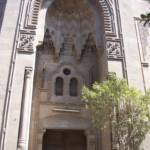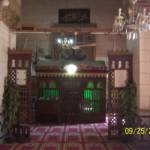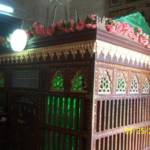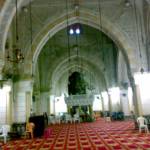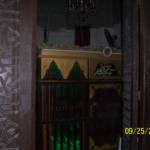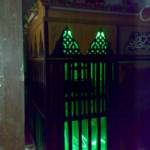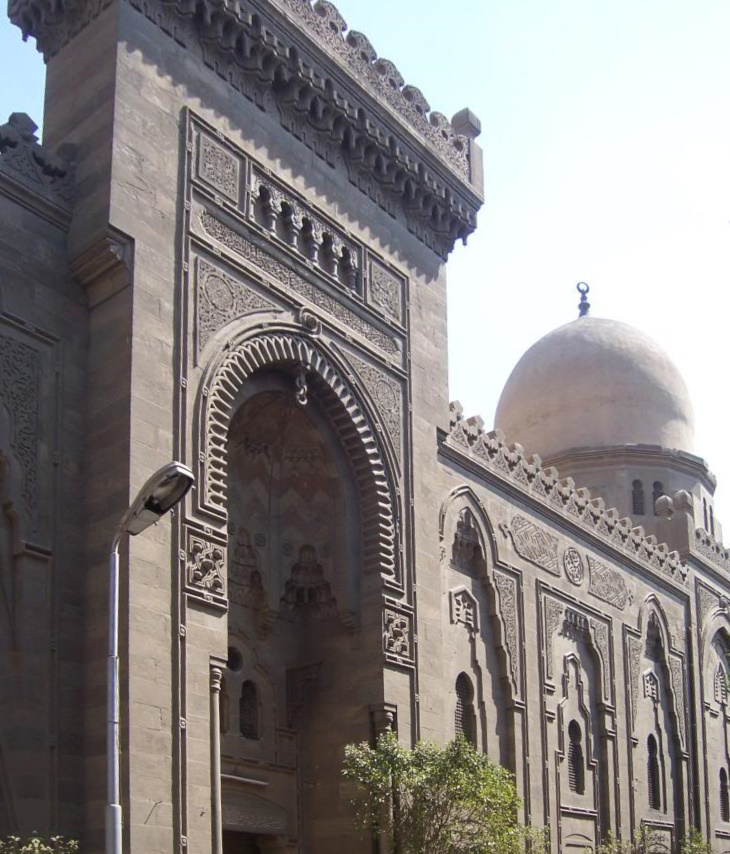Bio: Sh. Shams al-Din al-Hanafi | الشيخ سيدي شمس الدين الحنفي
Sh. Shams al-Din al-Hanafi al-Shadhili
الشيخ سيدي شمس الدين الحنفيb. 775 – d.847 H. (1443 CE) in Cairo
﷽
took the Shadhili path from Sayyiduna Nasir al-Din b. al-Maylaq,
who took it from his grandfather, Sayyiduna Abu’l-Abbas Shihab al-Din b. al-Maylaq,
who took it from Sayyiduna Yaqut al-Arshi,
who took it from Sayyiduna Abu’l-Abbas al-Mursi,
who took it from Sayyiduna Imam Abu’l-Hasan al-Shadhili.
English
From Kuhin: Tabaqat al-Shadhiliyya
He is the qutb and matchless pearl of his time, the shaykh of gnostics, and the sultan of saints. He is the treasury of the elect, the well of secrets, the manifestation of the suns of spiritual lights, the fifth caliph,[1] and the heir to the secrets of mystics. He is the one whom Allah established as a mercy to His servants, both in his own life and after. He is our liege and master, crown of the broad Islamic path and din, who leads wayfarers to their spiritual destination. He is the sign of God on earth crowned with secrets. He is adorned with the garment of the folk of truthfulness, unearthing wonders from the spiritual path, and the meanings of whose words dazzled perspicacious intellects. He is the master of young and old, the shelter of the folk of stability and firmness, the unparallelled qutb, the single and collective succour, our master Shams al-Din, Sultan Abu’l ‘Abdullah Muhammad b. al-Hasan b. ‘Ali al-Hanafi,[2] may Allah be pleased with him and may He make him pleased. May Allah support us by his spiritual sustentation and encompass us by His pleasure.
He was from the most illustrious shaykhs of Egypt and from the masters of gnostics. He was regaled with manifest miracles, splendid states, radiant stations and lofty spiritual ambitions. He was endowed with a pleasing spiritual illumination, a disclosure tearing apart the veils of normality, a promacy in the inward aspects of sanctified purity, ascension through the stairways of gnosis, and elevation across the ladders of ultimate realities.
He was among those who ruled over his secrets, curbed his states and seized control of his affair. He possessed far-reaching authority in effectively disposing of matters, a beneficent hand in judgments pertaining to sanctity, a firm foot in the steps at the end of the spiritual path, and the towering peak in steadfastness and solidity. He is among the pillars of this path, the vanguard of its pivots [awtad], its foremost imams and the cream of its scholars — in knowledge, action, state, word, abstinence, revival of the pristine way of tawhid, awe, and majesty. He is from those whom Allah Most High manifested unto existence, shifting around in the cosmos, entrenching in spiritual states, causing to verbalize aspects of the invisible world, bestowing benefits on their tongues and establishing as a model for seekers, so that a group of path’s folk graduated in his school and numerous men of virtue and saints affiliated to him, acknowledging his merit and endorsing his status. As a result, people sought him out from other regions, while he unlocked ambiguous issues concerning the states of the Sufis.
He possessed beauty in his physical appearance and in his attire, dressing in the clothes normally worn by kings and leaders. Beholding the Divine Beauty was predominant in him. People have devoted works of biography on him, authoring large tomes about his outstanding virtues. How could the likes of me summarize his virtues, or hover around this sanctuary? He is the master of all kings, the succour of Allah’s Friends from the East to the West — across valleys, land and sea. Let us, however, mention a few of his noble virtues. I thus say:
He — may Allah be pleased with Him and benefit [us] through him — was born in Egypt in AH 775. He grew up under the tutelage of his maternal aunt. When he reached his prime, he went to school and memorized the Qur’an, learnt from Ibn Hisham and heard hadith from our master al-‘Iraqi. After this, he decided to take a break from pursuing knowledge, whereupon he worked in a shop he had set up for himself. He sold books there until a caller of the All-Merciful came to him and said, ‘O Muhammad, you have not been created for this. Give up this shop, since the like of you is not suited to this business. You have a huge affair with Us.’ He accordingly gave up the shop and the stock he would sell in it, becoming preoccupied with love for his Creator and Originator.
He then withdrew into a solitary retreat for seven years, and came out manifesting sealed aspects of the ultimate reality, speaking about the secrets of sciences and disciplines, and understanding the recondite meanings of the Qur’an. As a result, the kings of mankind and jinn yielded to his authority and crawled to him, seeking to flatter him, while luminaries attested the fact that he had a vast affair among humans. They were saying this out of the bounty of the Lord of mankind. After his retreat, he took the spiritual path and its devotee at the hand of his guide and mentor, who took him to his destination and brought him near Allah, our master Nasir al-Din b. al-Maylaq. He in turn had taken the path from his grandfather, our master Abu’l-Abbas Shihab al-Din b. al-Maylaq,[3] the admonisher and guide who was regaled with saintly miracles and spiritual allusions, and who is buried in the Greater Shadhili Cemetery. He had in turn taken the path from our master Yaqut al-Arshi, who had in turn taken the path from our master Abu’l-Abbas al-Mursi and though him from our master Abu’l-Hasan al-Shadhili.
He had disciples who were like stars in the sky. They included:
■ Our master Abu’l-Abbas Ahmad b. Muhammad b. ‘Abd al-Ghani al-Sirsi. His spiritual station was comparable to our master al-Hanafi, and he was gifted spiritual unveilings. He passed away in the year AH 861 and was buried in the Shadhili Cemetery.
■ Our master Shams al-Din b. Katila al-Mahalli.
■ The latter’s in-law, our master ‘Umar, buried in his mosque.
■ Chief Justice Sharaf al-Din Yahya b. Muhammad al-Munawi al-Shadhili. He was — may Allah have mercy on him — a notable. Appointed as the shaykh of the Azhar Mosque, he was given the epithet “Shaykh al-Islam”. He would attend the gatherings of our master al-Hanafi, from whom he learnt and to whom he was closely associated. He would frequent him regularly, time after time. He died in 12 Jumada II AH 871.
■ Our master Siraj al-Din Abu Hafs ‘Umar b. al-Mulaqqin, the author of Tabaqat al-Awliya; who passed away in Rabi’ I in AH 804.
■ [Shaykh ]Al-Siraj al-Bulqini[4], the mujtahid of his age and the foremost scholar of the eighth century AH. He met his death — may Allah show mercy to him — in 10 Dhu al-Qa’da AH 805, and was buried in the middle of his mosque situated in Bab al-Sha`riyya, by the side of Bayn al-Sayarij. His shrine therein is visited by people.
■ Shaykh al-Islam al-Badr al-‘Ayni, who was the Chief Justice in charge of a notable judiciary, and who died on 4 Dhu al-Hijja AH 855. He was buried in his mosque known in the past in the area of Katama, and presently known in the public square of the Azhar quarter.
■ Sidi Shams al-Din’s own son, both biologically and spiritually, our master Mahmud al-Hanafi, buried behind his mosque.
■ Our master Abu Madyan al-Ashmuni, a descendant of Abu Madyan al-Tilimsani. He came to our master al-Hanafi, sat with him for forty days and attained perfection. Thereafter, he developed some virtuous associates and disciples of his. His shrine is named after him in Bab al-Sha’riyya, by a narrow alley in the Muqassam district. Of his children who are buried in his vicinity are Ahmad al-Shuwaymi and Ahmad al-Halfawi, may Allah be pleased with all of them.
He had many other disciples, whose number cannot possibly be ascertained. We have limited ourselves to the abovementioned ones.
The death of our master Shams al-Din al-Hanafi took place in Cairo in Rabi’ II AH 847. He was buried in his well-known mosque, which is regarded as one of Cairo’s largest. It is built with white stone and hoists a large minbar surmounted by lovely engravings close to it. The minbar is made of wood with an oyster veneer. In the courtyard of the mosque, there is an arched dome with coloured glass windows, while the roof of the mosque is made using lapis lazuli and coloured glass. To the right entrance of the large door there is a noble stall where his honourable mausoleum is found, topped by a splendidly constructed dome.
Sayyidi Shams al-Din al-Hanafi is one of the axial saints buried in Egypt. People set out for his tomb from far away localities and remote nations, hoping to find abundant good there. A Shadhili public session of remembrance [hadra] is performed there morning and evening.
This mosque is regaled with divine manifestations and breezes of goodness. It is redolent with the scents of musk and camphor due to the blessing of its residents, may Allah have mercy on them. No aggrieved person intentionally sets out for this mosque save that Allah helps him and eases his pursuit. Among the things that have been tried and tested is that if somone has a need, he should intentionally visit this mosque three days consecutively after the Dawn prayer.
His need will be fulfilled instantly. This matter is established by multiple transmissions among both the elite and commonality of Egypt, and proven by experience. There is no doubt about this.
O Allah, nourish us through his spiritual sustentation, settle us in his proximity and delight us by Your pleasure with us, O Allah, O Most Merciful of those who show mercy.
Footnotes:
[1] In a spiritual sense.
[2] You can read his biography in al-A’lam (6/88), Tabaqat al-Sha’rani (2/81-92), al-Kutubkhana (7/396), Dar al-Kutub (1/314), al-Sirr al-Safi (2/93) and Tabaqat al-Shadhiliyyat al-Kubra by Muhyi al-Din al-Tu’mi (p. 187).
[3] His biography can be found in Tabaqat al-Shadhiliyyat al-Kubra by Muhyi al-Din al-Tu’mi (p. 150).
[4] One of his major students being the great hadith scholar Ibn Hajar Al-Asqalani who continuously refers to him as Shaykh al-Islam in his writings.
Source: Muhammad b. Qasim al-Kuhin, Tabaqat Al-Shadhiliyyah Al-Kubra, translated by Ahmad Ali al-Adani as “Biographies of Prominent Shadhilis”
عربي
2. From Kuhin: Tabaqat al-Shadhiliyya: View book | Download | Chapter [34] ↓
[34] سيدي شمس الدين الحنفي([1])
(775- 847)
قطبُ الزمان، وواحدُ الأوان، وشيخ أهل العرفان، سلطانُ الأولياء، وسكردان الأصفياء، منبعُ الأسرار، ومظهر شموس الأنوار، خامس الخلفاء، ووارث أسرار الأولياء، من أقامه الله رحمة للعباد حيًّا وميتًا سيدنا ومولانا تاج الملَّة والدين، موصل السالكين، ومرشد الهالكين، آية الله في أرضه المتوج بالأنوار، المتحلّي بلباس أهل الصدق الأخيار، الآتي في الطريق بالعجب العجاب، الذي تحيرت من فهم معاني كلامه أفهام أولي الألباب، سيد الفتيان والشيوخ، وملاذُ أهل التمكين والرسوخ، القطبُ الفرد، والغوث الجامع الأوحد، مولانا شمس الدين السلطان أبو عبد الله محمد بن الحسن بن علي الشاذلي الحنفي رضي الله عنه وأرضاه، وأمدَّنا بمدده، وحفنا برضاه.
كان رضى الله عنه من أجلاء مشايخ مصر، وسادات العارفين، صاحب الكرامات الظاهرة، والأحوال الفاخرة الخارقة، والمقامات السنية، والهمم العلية، صاحب الفتح المؤنق، والكشف المخرق، والتصدر في بواطن القدس، والرقي في معارج المعارف، والتعالي في مراقي الحقائق.
كان له الباع الطويل في التصريف النافذ، واليدُ البيضاء في أحكام الولاية، والقدمُ الراسخ في درجات النهاية، والطود السامي في الثبات والتمكين.
وهو أحد من ملك أسراره، وقهر أحواله، وغلب على أمره.
وهو أحد أركان هذه الطريق، وصدور أوتادها، وأكابر أئمتها، وأعيان علمائها علمًا، وعملًا، وحالًا، ومقالًا، وزهدًا، وتحنيفًا ومهابة وجلالة.
وهو أحدُ من أظهره الله تعالى إلى الوجود، وصرَّفه في الكون، ومكنه في الأحوال، وأنطقه بالمغيبات، وأجرى على لسانه الفوائد، ونصبه قدوة للطالبين، حتى تلمذ له جماعة من أهل الطريق، وانتمى إليه خلقٌ من الصلحاء والأولياء، واعترفوا بفضله، وأقروا بمكانته، وقصد بالزيارات من سائر الأقطار، وحل مشكلات أحوال القوم.
وكان رضى الله عنه ظريفًا جميلًا في بدنه وثيابه، يلبس ملابس الملوك والأمراء، وكان الغالب عليه شهود الجمال، وقد أفرد الناس ترجمته بالتأليف، وألفوا في مناقبه مجلدات، وأنى لمثلي يحصر مناقبه، وكيف أحوم حول هذا الحمى؟ فهو سيد الملوك بأسرها، وغوث الأولياء من مشرق الأرض إلى مغربها، سهلها وبرها وبحرها، ولكن نذكر لك جملة من مناقبه الشريفة فأقول:
ولد رضي الله عنه ونفع به في مصر عام سبع مئة وخمسة وسبعين، ونشأ في حجر خالته، ولما ترعرع مضت به إلى الكتّاب، فحفظَ القرآن، وأخذ العلم عن ابن هشام، وسمع على مولانا العراقي، وبعد ذلك ظهر له أن يكفَّ عن طلب العلم، فجلس في حانوت أعده له، وصار يبيعُ الكتب إلى أن أتاه داعي الرحمن: يا محمد، ما لهذا خُلقت، فاترك الدكان، فمثلك لا يصح لهذا الشأن، فأنت عندنا كبير الشأن. فترك الدكان وما فيه، وهام على وجهه محبة في خالقه ومنشيه.
واختلى سبعَ سنين، فأظهر المكتوم، ونطق بأسرار العلوم والفنون، وفهم أسرار معاني القرآن، وخضعت لسطوته ملوكُ الإنس والجان، وأتوه حبوًا، وتذلَّلوا بين يديه، وشهدت له الأعلام بأن سيكون له شأنٌ عظيم بين الأنام، وقد كان ما قالوه بفضل ربِّ الأنام، وبعد أن خرج من الخلوة أخذ الطريق، وصار من أهل ذاك الفريق، عن شيخه ومربيه، وموصله ومُدنيه مولانا ناصر الدين بن الميْلَق، عن جده مولانا شهاب الدين بن الميلق أبي العباس الواعظ المذكر المربي صاحب الكرامات والإشارات، المدفون بقرافة الشاذلية الكبرى، عن مولانا ياقوت العرشي، عن مولانا أبي العباس المُرسي، عن مولانا أبي الحسن الشاذلي رضى الله عنه.
وكان رضى الله عنه له أصحاب، كالنجوم في السماء، منهم: مولانا أبو العباس أحمد بن محمد بن عبد الغني السرسي، كان رضى الله عنه في منزلة مولانا الحنفي، وكانت له مكاشفات، وتوفي رضى الله عنه عام ثمان مئة وواحد وستين، ودفن بقرافة الشاذلية.
ومنهم: مولانا شمس الدين بن كتيلة المحلي.
ومنهم: صهره مولانا عمر المدفون بمسجده.
ومنهم: قاضي القضاة شرف الدين يحيى بن محمد المناوي([2]) الشاذلي كان رحمه الله من الأعيان، تولى مشيخة الجامع الأزهر، ولقب بشيخ الإسلام، وكان يحضر مجالس مولانا الحنفي، فأخذ عنه: وانقطع إليه، وصار يتردَّدُ عليه كثيرًا المرة بعد المرة، توفي رضى الله عنه اثني عشر جمادى الآخرة عام ثمان مئة وواحد وسبعين.
ومنهم: مولانا سراجُ الدين أبو حفص عمر بن الملقن صاحب «طبقات الأولياء» المتوفّى في ربيع الأول عام ثمان مئة وأربعة.
ومنهم: السِّراج البُلقيني مجتهد عصره، وعالم المئة الثامنة، المتوفى رحمه الله عاشر ذي القعدة عام ثمان مئة وخمسة، ودفن بوسط مسجده بباب الشعرية بجهة بين السيارج، ومقامه ثم يزار.
ومنهم: البدر العيني شيخ الإسلام، وقاضي القضاة الأعلام، المتوفى رابع ذي الحجة عام ثمان مئة وخمسة وخمسين، ومدفون بمسجده المعروف بحارة كتامة، المعروف الآن بحارة الأزهري بالرحاب الأزهري.
ومنهم: ولده حسًّا ومعنى مولانا محمود الحنفي المدفون خلف مسجده.
ومنهم: مولانا أبو مدين الأشموني من ذرية أبي مدين التلمساني، جاء رضى الله عنه إلى مولانا الحنفي وجلس عنده أربعين يومًا وكمل، وصارت له أصحاب وتلامذة أخيار، ومقامه هو المشهور باسمه جهة باب الشعرية بخط المُقسم بالزقاق الضيق، ومدفون معه من أولاده مولانا أحمد الشويمي قبالته، ومولانا أحمد الحلفاوي رضي الله عن الجميع. وله أصحاب لا يحصى لهم عدد، اقتصرنا على ذكر هؤلاء.
وكانت وفاة مولانا شمس الدين الحنفي بمصر في شهر ربيع الآخر عام ثمان مئة وسبعة وأربعين، ودفن في مسجده المشهور، ويُعدُّ مسجده من أعظم مساجد القاهرة، مبنيٌّ بالحجر الأبيض، وبه محراب كبير، عليه نقوشٌ جميلة بجوار منبره، مصنوع من الخشب المحشي بالصدف([3])، وبصحن المسجد قبة معقودة بمنافذ من الزجاج الملون، وسقف المسجد مبني باللازورد([4]) والزجاج الملون، وعلى يمين الداخل من الباب الكبير المقصورة الشريفة، التي فيها ضريحه الشريف، وعليه قبة متقنة البنيان.
وهو أحد الأقطاب المدفونين بمصر، تقصده الناس من الأماكن البعيدة، ومن أقاصي الأقاليم والبلدان، ويرجون عنده خيرًا كثيرًا، وبه تقام حضرة شاذلية في البكرة والعشية.
وعلى هذا المسجد تجليات ونفحات، وروائح المسك والكافور عطرت ذلك المسجد من بركة ساكنيه رحمهم الله، وما قصد هذا الضريح مكروب إلا أعانه الله ويسر عليه طلبه، ومما جُرّب لقضاء الحاجات أن من كانت له حاجة إلى الله تعالى، وأراد قضاءها، فليقصد زيارته ثلاثة أيام متوالية بعد صلاة الصبح تُقضَ في الحال، وهذه المسألة متواترة بين خواص المصريين وعوامهم، وهي من المجربات، ولا شكَّ أنها كذلك، اللهم أمدنا بمدده، وأسكنا بجواره، ومتعنا برضاك عنا، يا الله يا أرحم الراحمين.
([1]) محمد بن حسن بن علي التيمي البكري الشاذلي، أبو عبد الله شمس الدين الحنفي: صوفي مصري، من أهل القاهرة. اشتهر بأخبار حكيت عنه مع السلطان فرج بن برقوق وغيره. له «الروض النسيق في علم الطريق» توفي سنة 847 هـ. [«الأعلام» (6/88)، «دار الكتب» (1/314)].
([2]) يحيى بن محمد بن محمد بن محمد بن أحمد، أبو زكريا، فقيه: شرف الدين بن سعد الدين الحدادي المناوي. شافعي، من أهل القاهرة، منشأه ووفاته بها، ولد سنة 798 هـ، ونسبته في الصعيد، أصله من منية بني خصيب، ولي قضاء الديار المصرية، وحمدت سيرته. توفي سنة 871 هـ ولما مات رثاه كثيرون. [«الأعلام» (8/167)، «شذرات الذهب» (7/312)].
([3]) الصَّدَفُ: غلاف يابس متصلب يغطي اللؤلؤ.
([4]) اللازورد: حجر كريم مشهور يتخذ للحلي.
Burial Place
Photos from the maqam of Al-Sultan al-Hanafi. The mosque it is located outside Cairo, and the Shaykh himseelf laid its foundations in the beginning of the 9th century hijri – may Alllah be pleased with him. His son-in-law Sidi ‘Umar (mentioned in the bioraphy as one of his students) is buried there as well.
يا نسل صــــديق النبى انتمى
لك لا يضام ودام فى عيش رغد
لا سيما من زار روضك قائلا
يا شمس دين الله يا حنفى مدد
هذا المقام على يسار السالك من شارع مجلس الامة إلى ميدان لا ظوغلى باشا بشارع السلطان الحنفى – أبو عبد الله ( محمد ) بن ( حسن ) وهو من ذرية سيدنا ( أبى بكر الصديق ) رضى الله عنه ولقبه ( الحنفى ) نسبه الى مذهبه وهو أحد من ملك أسراره وقهر أحواله وغلب على أمره وهو أحد أركان هذه الطريقة وصدور اوتادها واكابر أئمتها وأعيان علمائها علما وعملا وحالا وقالا وزهدا وتحقيقا ومهابا
يقول المقريزى فى الخطط جزء4 ص 326
هذا الجامع خارج القاهرة أنشأه الشيخ شمس الدين محمد بن حسن بن على الحنفى فى سنة 810هـ
أما على باشا مبارك فى الخطط ج 4ص 99
( يقول ) هذا الجامع تجاه الحنفى بين مسكة وسويقة اللالا أنشأه الاستاذ شمس الدين أبو محمود محمد الحنفى بجوار داره فى سنة 817 هـ كما فى المقريزى وله ثلاث أبواب أشهرها المفتوح على الشارع يعلوه شباك من الخشب الخرط الدقيق فى الصنع وبجواره على يسار الداخل مدفن الشيخ عمر شاه والشيخ عمر الركنى وكتب لتعليم الاطفال وسبيل والآخران عن يسار المصلى وضريح الشيخ بالجانب الايمن من الجامع ومن داخله قبة مرتفعة عليه مقصورة من الخشب كما هو موضح بالصور
المصدر: منتدى موقع د. محمود صبيح

